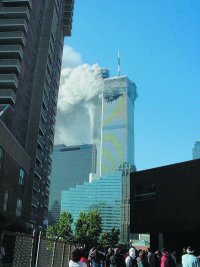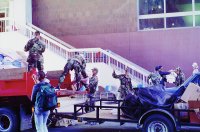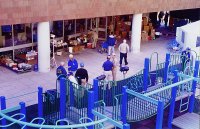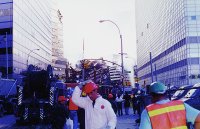| "I'll tell you the story
of how my library 'stayed open' technologically in the weeks following
the attacks. The way our network was designed was key to why we were able
to function even after a disaster of this magnitude."
|
The
Borough of Manhattan Community College (BMCC) is one of the 19 campuses
that make up the City University of New York. It is the largest community
college in the system, with a robust enrollment in part because of its
location near the downtown Wall Street area. It is, as we liked to say,
in the shadow of the World Trade Center. The college's main building at
199 Chambers Street is the size of the Empire State Building lying sideways;
it spans the length of 2 full city blocks. Our other building, the 15-story-tall
Fiterman Hall at 30 West Broadway, is only 3 blocks away from the main
campus, where a brand new virtual library center would have opened in January
2002.
The September 11 Attack
and Immediate Aftermath
It was a refreshingly crisp
September morning when the first plane crashed into North Tower of the
World Trade Center (WTC). I was on the phone with a librarian who had called
in sick at that same moment. I told the caller to get some rest because
something had just happened outside and someone might need help. From the
bone-chilling shriek I heard after a big bang, I originally thought that
a crane had toppled from a high-rise nearby, because there was some construction
work going on in the area. But when I raced outside and looked up, I saw
this unbelievable scene that did not quite resemble the pictures we later
saw either on TV or in print.
I saw these two majestic
twin towers against the backdrop of a cloudless blue sky, and everything
was still except that on the upper floors of the North Tower faint whiffs
of smoke were oozing out of a horizontally cut line. Who would have guessed
that a hijacked airliner had just made a clean incision across this metallic
body of stately steel? It was such a horrific sight that its physical contradiction
almost gave a perverted sense of extraordinary grandeur. The rest, as they
say, is history.
Thick smoke billowed out
as word quickly got around that a plane had crashed into the Trade Center.
Back inside, most of my staff and some students had gone to the southern
end of my library, where we had a direct view of the towers. As sirens
from emergency vehicles erupted everywhere, we began to see debris, shrapnel,
and, later, victims, falling from the inferno. People were stunned. At
this point we didn't know it was not an "ordinary" explosion but an act
of terror, so we were inclined to try to continue library business as usual.
| Click photos for full-size images.
|
 |
| Students
could see the WTC towers from our library (in the lower right).
|
 |
| The
National Guard unloads supplies at BMCC. We observed that the rescue
efforts were organized and methodical.
|
 |
| BMCC
became a command center after 9/11. Rescue workers confer in front
of the college's day-care center.
|
 |
| Burning
debris from the collapsed towers landed on the steps of BMCC's Filterman
building. Here, resue workers attempt to extinguish the flames.
|
Soon after, even as I tried
to turn the gathering crowd away from the windows, the second plane hit
the South Tower. It was then clear that we were under a terrorist attack.
Although I didn't have authorization, I told the gathering staff that those
who wished to leave might do so, since safety was an issue, but that I
would prefer for them to stay put—and away from the windows—just long enough
to hear official word. Soon, security personnel came to evacuate the building.
Two librarians made me promise to stay until they figured out their plans.
I had decided that I was
going to stay anyway, because in the uncertainty of the moment I feared
more attacks, and it seemed that my way home through the Pennsylvania Railroad
Station was unsafe. My logic was that if the attack continued, railroads,
tunnels, and bridges would be obvious targets. Sometime after 10 a.m.,
the WTC towers came down one after the other. I was following the news
from our library Web site, listening to the radio, and trying to track
down relatives all at the same time. Our site has national news headlines
that change every 15 minutes, and I remember thinking to myself that this
plug-in was quite handy.
When the dust from the collapsing
North Tower reached the perimeters of our main building, fear took the
better of me. Just before I finally left the library at about 1 p.m., I
actually took time to turn off the computers. Little did I know that we,
along with the rest of the neighborhood, would soon lose electric power
and water. As I exited through the back entrance, I found the cafeteria
swamped with battle-fatigued rescue workers. Some of them were calling
home on the pay phones while others were given refreshments, courtesy of
BMCC's president. Later that evening, electric power and all phone service,
including the two T-1 lines, were cut off.
That same afternoon, another
building, 7 World Trade Center, caught fire and eventually fell on and
clipped away part of the Fiterman Building, which had been a $32 million
gift to the college. The first three floors of the 15-story building were
in the midst of renovations to become a new library center with 400 flat-screen
computers on specially designed furniture. So far the college had spent
$65 million in renovations to the building. But considering that the Fiterman
staff that day had to escape through a basement exit, no one can quibble
over the loss of the communication infrastructure, including all fixed
CAT-5 wiring, switching cores, and cable trays, that was already in place.
It would be almost 2 weeks
before I returned to the campus, and 3 weeks before BMCC reopened. But
during that time I was not idle. My colleagues and I felt we had to keep
the library Web site up to serve our students with news and resources.
Our role as information managers is to keep reliable information flowing.
So, believe it or not, with the exception of the first 5 days, library
service was available online. I answered many e-mail reference questions
from home. We updated our site to include links to research on anthrax,
terrorism, and women in Afghanistan. I'll tell you the story of how my
library "stayed open" technologically in the weeks following the attacks.
The way our network was designed was key to why we were able to function
even after a disaster of this magnitude.
Managing Things from
Home
I live only an hour away
from Ground Zero, but commuting home on September 11 took on a special
meaning. After having to walk half of Manhattan to the Long Island Railroad,
I eventually got home after 6 p.m. on an almost empty train. Yet only a
few hours earlier, the public transportation system had been shut down,
and thousands upon thousands of New Yorkers were walking over the bridges
in pandemonium. It turned out to have been a good decision to delay my
return.
The next day, I started
trying to contact my staff members at home to check on them. I discovered
quickly that we Americans move around a lot. The list of phone numbers
I kept at home was sadly out of date. I called my secretary, but her list
was also incomplete. On top of that, the e-mail system we depended on was
no longer in service. I noted that I would have to update and expand the
list when we returned—surely we all had other e-mail accounts, which we
could use whenever the system became unavailable. One by one, by the time
payday came on September 13, I managed to call many of the staff members
to tell them where to pick up their checks.
On September 17, as soon
as it was confirmed that the college Web site was running again, I called
my Web technician. It had been nearly a week since that fateful Tuesday.
Since I did not want to use the version of FTP programs I had on my computer
at home, I asked my technician to put the news update on the library's
Web pages, highlighted by an orange "9/11/01," and also asked him to employ
a tricolor patriotic ribbon as the screen cursor. More significantly, I
had him move the Ask-a-Librarian link to the front page to make the service
more visible. This feature was linked to my own e-mail account, and I received
many inquiries. I also used my home e-mail to arrange for the CUNY Central
Office to halt book deliveries and to make changes in the system so that
BMCC students could renew library books at other CUNY campuses, which was
not covered by the existing open-access policy. This information was also
posted on our Web site.
During this period, the
administration moved its operations to one of our satellite locations at
125th Street, and the IT service moved to the CUNY Central Office's Computer
Center at 57th Street. Three members of the Media Center made the latter
move, retrieving the library server from Ground Zero literally in the dark,
a few days after the attack. Moving BMCC's base of operations allowed the
college's managers to provide hotline help, stress and grief counseling,
and other essential communication through a phone bank, the college Web
site, and the e-mail system. Both administratively and psychologically,
it was important to stay in control. Similarly, for the sake of our many
needy students, my goal was to continue offering baseline library information
service.
We held a staff meeting
on Friday, September 21 in the library itself to plan for our return. Seeing
one another face-to-face was reassuring.
Surviving with the Internet
The college reopened October
1, but we still had to wait more than a week to get limited Internet access
back through a different commercial carrier. Throughout, if you were accessing
the library pages from the outside, you wouldn't have known there was any
interruption of service. This was a miracle made possible by the Internet
and by the communication infrastructure that we had in place. When you
think about it, ours was not only a library without books; it was a library
without librarians. The fact that our Web site was stable and functional
was not coincidental. When you plan for a sufficient number of circumstances,
you'll be prepared for many problems, however unforeseen. Now I will discuss
the simple and redundant aspects of our library Web site, as well as the
concept of database-driven content. With concerted effort, any library
can achieve the same setup we had.
| "My colleagues and I
felt we had to keep the library Web site up to serve our students with
news and resources."
|
Our Development Strategy
Was to Keep Things Simple
What was important in BMCC's
experience was the strategy to make the virtual library our centerpiece.
Our idea for a virtual library was born with the donation of the Fiterman
building in 1998. We decided that instead of replicating what the college
had in the main building, we'd establish a virtual library center there
by using 400 networked computers. It would contain three distinct components:
the browser-based interface, the data communication structure, and a physical
location.
1
The BMCC library site as
a portal has two sections: the main library pages and the virtual library
pages. Although seamlessly linked as well as overlapped, the pages in the
main section are static HTML pages, while those in the virtual library
section are driven by a database as a back end. HTML pages are written
on the fly when a user makes an inquiry. This approach keeps the number
of static pages low.
We use static HTML pages
to provide links to the CUNY online catalog, online indexes, useful Web
sites, help section, and general information about the library. Following
the lead of the pioneer W3 Virtual Library Project, our library is a core
collection of Internet links organized by subject (based on the academic
departments), and by format (Web sites, e-journals, e-texts, and e-reference).
This makes unmediated searching from home easier. We added to this core
collection of resources other online library services and resources such
as e-books, full-text articles, government documents, e-reference, e-reserve,
etc. Other accessories include library information and a news feed.
Physically, the pages of
the main library site are kept in the college's Web server. This is the
case because in 1998 the college server had little else as its content,
and the library did not have the resources to run an independent server.
The virtual library, which is literally in a box, also houses the proxy
service. The proxy has been important to us because BMCC has an extensive
list of full-text databases that are accessible only through recognizable
IP addresses. After the attacks, when everyone (including the librarians!)
had to access all resources from off-site computers, our proxy setup turned
out to be essential.
Relocating the Server
We have kept our Web site
relatively small through skillful programming. All the files put together
consume about 10 megabytes of storage. If we put the content of our Web
site in text files (minus the graphics) it will take up about 10 floppy
disks, and only 2 disks if we compress the files. In either case, a CD
or a Zip disk allows a staff member to carry the whole library around.
That fact turned out to be one of the things that saved us.
There are many heroes at
different levels who helped the college recover from the tragic event.
As my primary concern is maintaining library service, the real heroes for
me are the two staff members and their supervisor from the Media Center
who carried the Web server uptown by subway. Without them, the virtual
library would not have existed for 23 weeks because the server would
have been out of reach. On Monday, September 17, the three of them met
at the BMCC's temporary headquarters at 125th Street. They rode the subway
until 14th Street, as far as it would travel following the attack. From
there, they were escorted for the next four subway stops by BMCC's security
detail in a clearly marked squad car to gain entry to the restricted area.
Soldiers guarded the area around Ground Zero as if it were a war zone.
The security at that point was so tight that any unexpected action, such
as taking photographs or hanging up a banner on the roof, would be met
by gun-toting soldiers. After the three had been identified, they were
instructed to don hard hats and masks as safety precautions. In the glare
of a heavy-duty flashlight, they entered from the far end of the main BMCC
building and disconnected the library server. They then took the time to
turn off other remaining computer devices. The reason for doing that was
to avoid the power surge that could occur when electricity returned later.
Luckily, the library server was not heavy. With the server and a scanner,
the three staff members quickly retraced their steps back to CUNY's Computer
Center at 57th Street.
We found that mapping the
files and setting up the server in the new location was simple because
the CUNY Computer Center has always been our Internet service provider
(ISP), and we use the same interface card. A word to the wise: Always use
standard products to be sure your systems are compatible with as many other
systems as possible.
Students Return to BMCC
When the students finally
returned on October 1, the library was facing a different set of problems.
Since the central station of Verizon's telecommunications operations had
been destroyed with the WTC buildings, that left local law enforcement,
government agencies, and big businesses competing for the remaining bandwidth
from alternative carriers. Can you guess who would get priority to have
their phone lines restored—BMCC, the FBI, or FEMA? As a result, we still
had no phone or Internet for almost 3 weeks. A high-tech library like ours
suddenly needed a high-touch solution. We had meetings and sent out memos
to make sure the staff understood the need to be in control, and to make
the students feel safe and welcome. I stressed the following areas:
-
The circulation desk reverted
to the manual system of bygone years. We limited checkout to three books
per student, and provided an extended grace period for overdue books. The
students were very understanding and grateful.
-
I had many of the fluorescent
lights replaced with new ones throughout the library, and had the entrance
repainted, including a 45-foot-long mural. This made the library appear
bright and fresh.
-
Even though there was no Internet
access, I made sure all the new iMacs on the open floor were turned on.
Psychologically, I wanted the students to feel that the business of education
was continuing—and it was.
-
Near the library entrance,
we displayed the many touching letters and communications that we had received
from all over the country. Students could read for themselves that the
world shared their trauma and cared about BMCC and New York.
-
So that students could search
for books without the computers, we distributed a guide to the Library
of Congress classification and the stacks. The LC Subject Guide stayed
open at the reference desk to identify or to approximate call number ranges
in the stacks. This worked quite well.
-
When limited phone service
was restored, the head of reference made arrangements with sister schools
within CUNY to take some of our reference calls if necessary. The New York
Library Association offered a list of its member institutions that volunteered
to help. Its gesture was much appreciated.
-
I alerted both students and
staff that a team of seven nondenominational chaplains was available if
they wanted to discuss their personal feelings and other issues, either
privately or in groups.
Planning for Disasters
At this point, it would
be natural to raise the issue of having a formal disaster plan. There are
many practical reasons to have a formal plan. If nothing else, it is the
tool to raise awareness among library staff.
Here at BMCC we can proudly
point out that we had such a written plan, and we also had a so-called
"disaster closet" where we kept plastic sheets, a dehumidifier, mops, and
over-sized pails. As you can surmise, our concern prior to 9/11 was water
damage. In truth, what saved the library from a total disruption of service
was technology. Let me share some of our disaster plans and what ended
up saving our systems.
-
Keeping the Web site small
was important because we were able to physically pick up one small server
and move it when necessary.
-
No system, not even a well-planned
one, can operate without electrical power. We were without power for so
many days that no matter what kind of UPS (Uninterrupted Power Supply)
devices we had used, the servers would have been useless unless we moved
them to another location the way we did. Even then, without phone service,
you can still be powerless. So it's a good idea to create redundant paths
for communication and to keep Internet resources on different hosts. In
the future we'll also keep a copy of the Web site with a hosting service.
-
We learned the importance of
having a list of all the staff members with their home phone numbers and
e-mail addresses, as well as some alternative numbers and addresses. In
our experience, at first people had no way to communicate with me, even
though I also have an AOL account. I missed the first emergency meeting
because my provost did not have my current phone number. When the college
issued me a cellphone after the attack, I immediately put that number on
the Web site so that people could call me to relate messages to my staff.
2
-
The appropriate staff members,
who have been trained, should carry a list of passwords so that they can
do their work remotely if need be.
-
If a Web site is carefully
and regularly backed up, ideally following the same directory structure,
then any trained technician can bring it back up on another server. Mapping
the address is a relatively easy undertaking. In any failover effort, files
will be transferred seamlessly and the site can be reconfigured for use.
To make mapping easier, a domain name is always preferable to a raw IP
address.
-
If you want to research disaster
planning, ALA provides a representative list of resources on its Disaster
Preparedness Clearinghouse Web site (http://www.ala.org/alcts/publications/disaster.html).
SOLINET recommends a convenient template of a disaster plan at http://www.solinet.net/presvtn/leaf/displan.html.
The published plans of Stanford and the University of Pittsburgh are useful
examples as well. They both include sections on how to deal with digital
data.
Getting Back on Track
The official fate of Fiterman
Hall is still undecided, and with it the virtual library center. Is the
building still structurally sound? All the relevant parties are looking
at a price tag of $240 million to completely replace the building, or $45
million to repair it. Skeptics would ask, why would the insurers want to
pay more if a fraction of that amount will do? Instead of waiting for this
to play out, BMCC is setting up an uptown campus with 30 trailers on the
grounds of City College. Under this plan, classes were scheduled to begin
in January 2002. The college has to bring in from the outside all necessary
services, including security, electricity, telecommunications, and other
academic supports. It certainly puts the virtual library concept to the
test. Meanwhile, every day when I walk past Fiterman Hall, the remaining
stainless steel facade is a painful reminder of what might have been. The
future of the building will be decided by either the engineers or the court,
or by both. The contents of the building, however, have been condemned
as a result of potential contamination by hazardous pollutants. So far,
the college has spent $4 million from its operating budget to bring students
and faculty back and to finish the fall 2001 semester. Luckily, all my
staff members were unhurt, and they all came back to work with me on October
1.
BMCC took out a full-page
advertisement in major newspapers to announce the reopening of the college
with this slogan: We Are Stronger Than Ever. This is exactly our library's
sentiment. Group discussions, memorial services, t-shirts, banners, and
literature made the library the heart of the campus, and its beat goes
on.
|